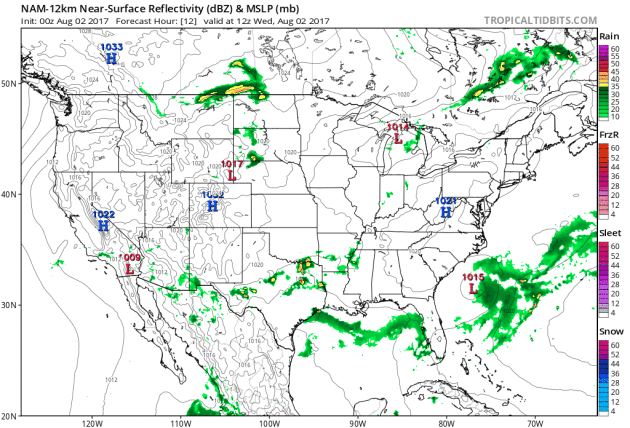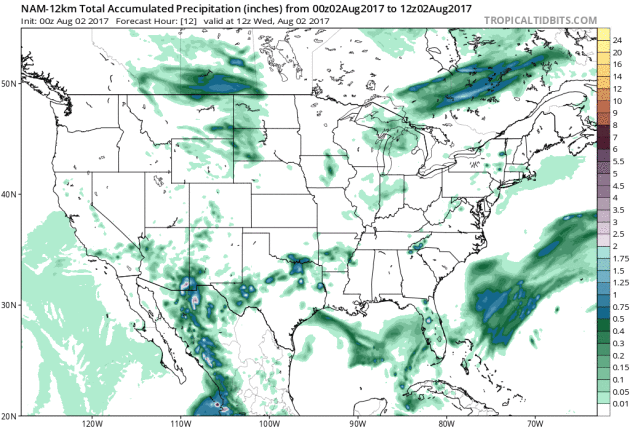89 F. maximum temperature in the Twin Cities on Tuesday.
83 F. average high on August 1.
85 F. high on August 1, 2016.
August 2, 1831: Unseasonably cool air moves into Minnesota with light frost reported at Ft. Snelling.
What August? Cool, Rainy Correction by Thursday
"In the long dusks of summer we walked the suburban streets through scents of maple and cut grass, waiting for something to happen" wrote Steven Millhauser in "Dangerous Laughter".
"In the long dusks of summer we walked the suburban streets through scents of maple and cut grass, waiting for something to happen" wrote Steven Millhauser in "Dangerous Laughter".
August is
a very good month to soak up a Minnesota summer: the risk of hail,
tornadoes and flash flooding recedes. The worst of the heat is behind
us, at least in theory. Days are still long, with enough humidity to
beckon us to the lake.
I see a cool bias for
Minnesota, Wisconsin and much of the central USA into mid-August - more
free A/C on the way. Enjoy low 80s today because Thursday will feel more
like early October, with highs in the 50s and low 60s. Models print out
1-2 inches of rain Thursday, with a few PM instability showers spilling
into the weekend. Plan any outdoor activities for morning or midday
Saturday & Sunday and you have a pretty good shot.
Drought
continues to deepen from the Dakotas into Montana, affecting the price
of wheat. August can bring rapid drying, but I don't see that for
Minnesota.
Don't write off more 90s by late summer. Hey, the State Fair attracts hot fronts!
Wheat Prices Fall as Drought Worsens. Todd Hultman has an update at The Progressive Farmer; here's an excerpt: "Heading
into August, we have had plenty to talk about in grains this year. But
the king of price moves so far has been Minneapolis wheat, where drought
in the northwestern Plains wreaked havoc with this year's spring wheat
crops. The shorthand explanation is that drought caused spring wheat
prices to go higher. That is true, but beware of a common trap that
comes with that easy explanation. For producers and traders both, this
year's spring wheat rally offers a good example of what to expect from
prices in drought situations..."
Image credit: "This
chart compares September Minneapolis wheat prices in 1988 and 2017 --
two years when drought was a serious problem in the northwestern Plains.
In 1988, prices peaked long before drought conditions got better and
the same appears to be happening in 2017." (Source: DTN ProphetX).
Graph credit: "Total solar irradiance data (red) and linear trend (orange) since 1950 from the Laboratory for Atmospheric and Space Physics Solar Irradiance Data Center at the University of Colorado." Illustration: Dana Nuccitelli.


Photo credit: "Grand Caillou Elementary School is surrounded by floodwater in September 2008 after Hurricane Ike. Repeat flooding forced the school to close and move to higher ground." The Courier and Daily Comet/File.
Navy Testing Small Robotic Drones to Monitor Hurricanes and Natural Disasters. A story at Daily Mail Online made me do a double-take: "The
U.S. Navy is testing tiny robot drones that fly in swarms like cicadas
to collect data. The CICADs - or 'close-in covert autonomous disposable
aircrafts - are designed to be cheap enough that a bunch can be dropped
simultaneously from the sky and even into storm conditions like
hurricanes. The Naval Research Lab has been working on the technology in
various ways since 2011, but the focus of this specific iteration - MK5
- is a shape that would allow them to be stackable..."
Tesla Surprises With 310-Mile Range Model 3. Here's a clip from ThinkProgress: "...The
car makes Tesla the leader in “price-per-mile of vehicle range.” In
fact, nobody but Tesla sells a 300-mile range electric car, and
Bloomberg’s Tom Randall calls it
“a jaw-dropping new benchmark for cheap range in an electric car.” OK,
“cheap range” may not be the perfect phrase for a car sold at these
prices — but Tesla is really competing with the high-end of the mass
market cars. “BMW and Mercedes should be concerned,” Bloomberg warns..."
Image credit: "The unexpectedly sleek and button-free dashboard of Tesla’s Model 3." CREDIT: Tesla.
HBO Hacked: Game of Thrones Data Leaked. You just don't want to mess with Jon Snow, do you? Here's an excerpt from Entertainment Weekly: "...HBO
recently experienced a cyber incident, which resulted in the compromise
of proprietary information,” the network confirmed in a statement. “We
immediately began investigating the incident and are working with law
enforcement and outside cybersecurity firms. Data protection is a top
priority at HBO, and we take seriously our responsibility to protect the
data we hold.” Hackers claimed to
have obtained 1.5 terabytes of data from the company. So far, an
upcoming episode of Ballers and Room 104 have apparently been put
online. There is also written material that’s allegedly from next week’s
fourth episode of Game of Thrones. More is promised to be “coming soon...”
Dog Flu Cases Reported in Several Minnesota Counties. Star Tribune has the latest: "A
rash of fast-moving canine influenza across several eastern and central
Minnesota counties has prompted the state Board of Animal Health to
start tracking the spread of the virus. Dr. Courtney Wheeler, a
veterinarian with the state board, said seven dogs had tested positive
for the virus as of Friday in Crow Wing, Kandiyohi, Ramsey, Sherburne
and Wright counties, and the number of infected dogs is growing. The
board updates its website with information about new cases every time a dog tests positive for the flu..."
The Case of "The Incredible Shrinking Airline Seat" is Finally Being Investigated. To which we raise our collective hands and shout HALLELUJAH! Yahoo Finance reports: "These
days, airlines get to decide how much legroom they give passengers. But
a new court order is pressuring aviation officials to set a mandate for
seat size. On July 28, judges on the United States Court of Appeals for the District of Columbia called out the Federal Aviation Administration (FAA), urging it to review what one judge called, “The Case of the incredible Shrinking Airline Seat.”
The court order was actually inspired from a petition originally filed
by Flyers Rights in 2015. In that document, the consumer advocacy group
raised concerns over the safety of passengers if seats continued to
decrease in size. They believe that passengers wouldn’t be able to
swiftly vacate a plane in an emergency, because the cabin is so cramped
with seats. The petition also points to health concerns, like deep vein
thrombosis, which can occur if blood flow is restricted in the leg..."

TODAY: Fading sun, still warm. Winds: N 5-10. High: 82
WEDNESDAY NIGHT: Clouds increase, showers late. Low: 60
THURSDAY: Unseasonably cool, heavy rain likely. Winds: NE 10-15. High: 64
FRIDAY: Drier, mix of clouds and sun. Winds: NW 8-13. Wake-up: 56. High: 76
SATURDAY: Some early sun, few PM showers. Winds: SW 5-10. Wake-up: 57. High: 73
SUNDAY: Partly sunny, late PM shower. Winds: N 7-12. Wake-up: 56. High: 77
MONDAY: Sunny and pleasant. Winds: SW 7-12. Wake-up: 58. High: near 80
TUESDAY: Warm sunshine, feels good. Winds: SW 7-12. Wake-up: 61. High: 82
THURSDAY: Unseasonably cool, heavy rain likely. Winds: NE 10-15. High: 64
FRIDAY: Drier, mix of clouds and sun. Winds: NW 8-13. Wake-up: 56. High: 76
SATURDAY: Some early sun, few PM showers. Winds: SW 5-10. Wake-up: 57. High: 73
SUNDAY: Partly sunny, late PM shower. Winds: N 7-12. Wake-up: 56. High: 77
MONDAY: Sunny and pleasant. Winds: SW 7-12. Wake-up: 58. High: near 80
TUESDAY: Warm sunshine, feels good. Winds: SW 7-12. Wake-up: 61. High: 82
Climate Stories...
Seas Rises, Trees Die. Climate Change Before Your Eyes. ABC News reports: "They're
called "ghost forests" — dead trees along vast swaths of coastline
invaded by rising seas, something scientists call one of the most
visible markers of climate change.
The process has occurred naturally for thousands of years, but it has
accelerated in recent decades as polar ice melts and raises sea levels,
scientists say, pushing salt water farther inland and killing trees in
what used to be thriving freshwater plains. Efforts are underway
worldwide to determine exactly how quickly the creation of ghost forests
is increasing. But scientists agree the startling sight of dead trees
in once-healthy areas is an easy-to-grasp example of the consequences of
climate change. "I think ghost forests are the most obvious indicator
of climate change anywhere on the Eastern coast of the U.S.," said
Matthew Kirwan, a professor at Virginia Institute of Marine Science who
is studying ghost forests in his state and Maryland. "It was dry, usable
land 50 years ago; now it's marshes with dead stumps and dead trees..."
Photo credit: "In
this July 16, 2017, photo, the sun rises on a "ghost forest" near the
Savannah River in Port Wentworth, Ga. Rising sea levels are killing
trees along vast swaths of the North American coast by inundating them
in salt water. The dead trees in what used to be thriving freshwater
coastal environments are called “ghost forests” by researchers. (AP Photo/Stephen B. Morton).
Map credit: "Estimates for mortality due to fine particulate matter in 2100. Orange and red shading indicate areas where mortality will increase by thousands or tens of thousands, respectively. Light blue and dark blue show where mortality will decrease by thousands or tens of thousands, respectively." Map by Silva RA et al., Nature Climate Change, 2017.
Mysterious Craters Blowing Out of Russia Could Mean Trouble For the Entire Planet. Again, what could possibly go wrong? Here's an excerpt from MSN.com: "In northern Siberia, rising temperatures are causing mysterious giant craters — and even more dire consequences could be in store, say climate scientists. The Russian province's long-frozen ground, called permafrost, is thawing, triggering massive changes to the region's landscape and ecology. It could even threaten human lives. "The last time we saw a permafrost melting was 130,000 years ago. It's a natural phenomenon because of changes in the earth's orbit," said professor of earth sciences at the University of Oxford, Dr. Gideon Henderson. "But what is definitely unprecedented is the rate of warming. The warming that happened 130,000 years ago happened over thousands of years … What we see happening now is warming over decades or a century..."
Photo credit: CNBC.
No comments:
Post a Comment